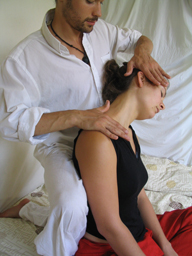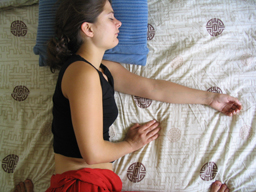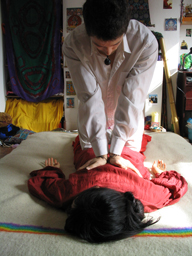
What is Traditional Thai Massage?
Thai Massage was developed 2500 years ago, essentially from the Indian Ayurvedic and Yogic traditions. It is performed on a mat on the floor on which the client is lying or sitting, and the client remains fully clothed throughout the treatment. There are hundreds of techniques which may be used but most of them involve palming (placing the palms on the client's body and smoothly pressing or rolling the flesh), thumbing (in particular the body's energy lines or 'sen'), application of pressure on specific crucial points on the body, and gentle stretching and manipulation (for this reason it is sometimes called 'Lazy Man's Yoga').
What are its effects?
Stretching and palming naturally tend to increase blood and lymph flow, effectively ventilating stagnant tissues, improving supply of nutrients, immune factors and causing toxins to be removed. They loosen the fasciae (connective tissues), thus liberating blocked and hardened regions, allowing the body to move more freely. They also work on the joints, realigning bones that have moved out of place (generating 'clicks' or 'clunks') and ventilating the joints, enabling fluid movement in and out. More important than these physical effects, however, the massage allows the client to 'let go' of tension held in the body, the result of which is that one tends to feel mentally very relaxed and open, and also energised because these tensions block the natural flow of energy through the body.

Receiving Thai Massage invites us, from a position of calm awareness, to observe tensions, holding patterns, blocks, and let them go. We release these energy blocks, and thus our energy flow improves and our bodies are able to function and heal themselves more effectively. Our bodies feel lighter, more fluid, more robust. These tensions are not simply physical, and thus the massage can bring about emotional catharsis and reveal suppressed memories, if we are ready to allow that to happen.
What do you need to do?
If you decide to have a treatment, it will improve the effectiveness of the massage a great deal if you drink plenty of water in the few days leading up to the massage, 1 1/2 to 2 litres per day, spread throughout each day (not all at once!). Fully hydrated tissues are more open and less dense than dehydrated ones, and so the massage can be deeper without causing pain. Muscle tissues can, however, take up to two months to become fully hydrated, so it's better to drink a good amount of water every day in any case. It is also important to drink water in the few days after the massage as toxins are released from the tissues and need to be flushed away.

It helps to wear loose and/or flexible clothing for the massage, especially below the waist, as parts of the massage involve manipulation of the legs. Jeans are a common cause of difficulty. Nevertheless, do make sure that you will be warm enough, bearing in mind that you'll be very inactive for a long time. A warm jumper presents no impediment to the massage. It's also better to remove any hard items from hands, wrists, pockets etc. or you may feel discomfort when they are pressed into your skin.
If the massage is to be performed in a space that you have specified, you will need an appropriate area of floor space, at least large enough for a double bed. The space should be reasonably well-protected from disturbances.
It's important to be aware of any injuries or susceptibilities and discuss them before the massage. Conditions such as hypermobility, diabetes and scoliosis are relevant, as are bruises, cuts, burns, susceptibility to cramp etc. Amazingly sometimes people even forget to mention sprained joints, slipped discs and pregnancy!
|